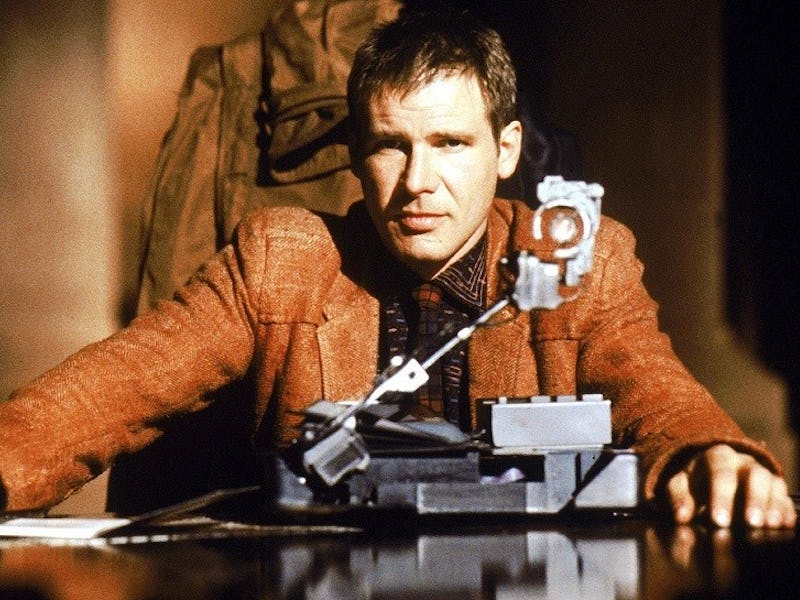Original 'Blade Runner' Book Sequels Implied Deckard Was Human
Before '2049,' the officially sanctioned book sequels seemed to imply Harrison Ford wasn't a robot.

This year, Blade Runner 2049 will revisit the surly robot-hunting detective Rick Deckard (Harrison Ford), last seen getting into an elevator, or maybe driving a car with his robot girlfriend Rachael (Sean Young). Depending on which of the myriad cuts of the movie you remember best, it’s either heavily suggested Deckard is a replicant (robot) or it’s not. Since the question of Deckard’s humanity (or lack thereof) is the original sci-fi fan theory debate, the new movie will probably have to address it. But, there have been “official” Blade Runner sequels before, and not once did those stories suggest Deckard was anything but totally human.
Between 1995 and 2000, three Blade Runner book sequels were published, all written by K.W. Jeter. Beginning with the 1995 book Blade Runner 2: The Edge of Human, these books were touted as “official” sequels to the 1982 film and were fully authorized by the estate of Philip K. Dick. This is a little weird because the books aren’t sequels to Dick’s novel Do Androids Dream of Electric Sheep? upon which Blade Runner was loosely based, meaning an endorsement from the Dick estate feels retroactively more like a marketing ploy than anything.
Still, if you cared about what happened in the cinematic world of Blade Runner after the first film, the Jeter books are pretty much your only option. Unsurprisingly, the first installment, The Edge of Human, focused on what Deckard and Rachael are doing after the events of the first film. Deckard is hiding in shack and using salvaged tech from the Tyrell Corporation to keep Rachael alive longer than the four-year lifespan most of the Nexus-6 replicants were given.
Deckard ends up confronting the human version of Roy Batty, the template for the replicant Roy Batty from the first movie. Deckard also encounters the template for Rachael in this book, a faux-human Rachael named Sarah Tyrell. So, in terms of replicant lore, the big takeaway of Blade Runner 2: The Edge of Human was that Rachael was based on a human and so was Roy Batty. Since we’re unlikely to see either Rachael or Batty in the forthcoming Blade Runner 2049, the only plot element that is similar in the new film is the idea that Dekcard is retired and in hiding.
In the second book, Replicant Night, Deckard ends up living with the human version of Rachael, Sarah Tyrel. But then book introduces a child version of Rachael. Time warps are involved here plus a lot of confusion as to where Sarah originally came from. And the centerpiece of this book is also a documentary/biopic being filmed about Deckard’s life. While it’s doubtful the new film will use this idea, it’s kind of a shame. It would be great if Ryan Gosling’s character, Agent K, hit up Deckard with a biopic deal for the Lifetime network in those new trailers.
By the time of the third book, Eye and Talon, child Rachael and Deckard briefly appear to steal that synthetic owl owned by Papa Tyrell from the first movie. It seems Deckard needs material from that owl in order to sustain the child version of Rachael … or something. The owl also bizarrely has a name: Scrappy.
With all the attention paid to dueling Rachaels, faux-owls, time warps, and biopics being made about the life and times of Deckard, the main character, Mr. Blade Runner himself, remains human throughout it all. Meaning, if an innocent fan is looking for clues as to what direction the Blade Runner sequels have taken prior to Blade Runner 2049, these books tell a strange tale: a world in which it’s assumed Deckard is human and that a continuation of his story would include Rachael. But, with Blade Runner 2049 coming this fall, the chances of Rachael showing up are nearly zero, while the idea of Deckard really being a replicant remains a mystery … for now.